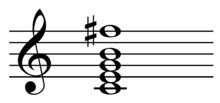Lydian chord

In jazz music, the lydian chord is the major 7♯11 chord,[1] or ♯11 chord, the chord built on the first degree of the lydian mode, the sharp eleventh being a compound augmented fourth. It is described as "beautiful" and "modern sounding."[1] The 7#11 chord generally resolves down by half step while the enharmonically equivalent 7(♭5) generally resolves up a fourth to the tonic[2] being a dominant chord (♯11=♯4=♭5, see octave equivalency).
Major 7(♯11) may also refer to the Lydian augmented chord, an augmented seventh chord with augmented fourth appearing in the Lydian augmented scale ![]() Play .[3]
Play .[3]
In a chord chart the notation, "Lydian" indicates a major family chord with an added augmented eleventh, including maj7♯11, add9(♯11), and 6(♯11).[1]
Harmonic function
Lydian chords may function as subdominants or substitutes for the tonic in major keys.[4]
.png)
Lydian (CΔ♯11):
r 3 5 7 (9) ♯11 (6))
- The Lydian chord has a peculiarity, in that placing the root both above and below the augmented eleventh creates an unpleasant dissonance of a tritone.
- The interval of the sixth is used even though it is described after other compound intervals, and perhaps should also be a compound interval (i.e., 13th). However, convention in Jazz dictates that when describing the major sixth, the simple interval, i.e., 6 is almost invariably used instead of the compound interval, i.e., 13. This helps avoid confusion with the dominant thirteenth. However, this trend has been almost reversed in more recent evolutions of jazz.
.png)
The dominant 7th ♯11 or Lydian dominant (C7♯11) comprises the notes:
r 3 (5) ♭7 (9) ♯11 (13)
Basing this chord on the pitch C results in the pitches:
C E G B♭ D F♯ A
The same chord type may also be voiced:
C E B♭ F♯ A D F♯
This voicing omits the perfect fifth (G) and raises the major ninth (D) by an octave. The augmented eleventh (F♯) is also played twice in two different registers. This is known as "doubling".
Sources
- 1 2 3 Juergensen, Chris (2006). The Infinite Guitar, p.50. ISBN 1-4116-9007-9.
- ↑ Juergensen (2006), p.51.
- ↑ Munro, Doug (2002). Jazz Guitar: Bebop and Beyond, p.39. ISBN 978-0-7579-8281-1.
- ↑ Miller, Scott (2002). Mel Bay Getting Into Jazz Fusion Guitar, p.44. ISBN 0-7866-6248-4.
- ↑ Benward & Saker (2009). Music in Theory and Practice: Volume II, p.185. Eighth Edition. ISBN 978-0-07-310188-0.